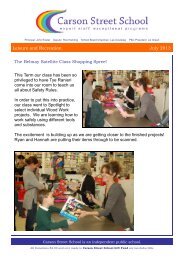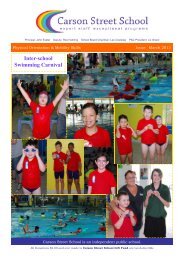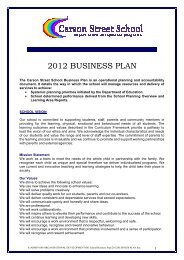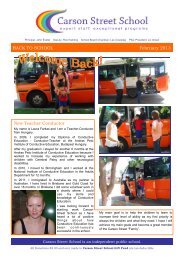What is play? - Carson Street School
What is play? - Carson Street School
What is play? - Carson Street School
You also want an ePaper? Increase the reach of your titles
YUMPU automatically turns print PDFs into web optimized ePapers that Google loves.
• Join in your child’s <strong>play</strong><br />
Help your child with their <strong>play</strong> by becoming a needed part of it. Play with toys<br />
that the child needs help to use. If your child <strong>is</strong> building a tower, give them<br />
the blocks or take turns putting a block on the tower. If your child <strong>is</strong> driving a<br />
car, put a person in the car, or set up a road on the floor. If your child likes<br />
rough and tumble <strong>play</strong> you can <strong>play</strong> chasing, tickling, tumbling, climbing, and<br />
spinning. If your child likes to run sand through her fingers, join her by<br />
pouring sand on her hands with a cup. You can <strong>play</strong> water games and help<br />
by filling the containers for the child to pour the water from. You should take<br />
only a short time for your turn in any game. Children find it hard to wait for<br />
their turn. If you take too long the child will lose interest and consequently lose<br />
the opportunity to learn how to take turns.<br />
HELP YOUR CHILD TO THINK AND PLAN<br />
• Help your child to plan<br />
You can create opportunities for example, when your child <strong>is</strong> on a swing,<br />
stand in front of her and push her a few times. Then wait to see whether she<br />
indicates that she wants more.<br />
• Help your child to think<br />
During <strong>play</strong> with toys that have similar parts (e.g. blocks, marbles, puzzles<br />
etc,) give your child one piece at a time and wait for her to indicate that he<br />
wants more. Once your child <strong>is</strong> familiar with all of the parts of an activity, give<br />
your child only part of the object or materials she has requested and wait to<br />
see whether she asks for what’s m<strong>is</strong>sing. For example, when your child <strong>is</strong><br />
<strong>play</strong>ing with a train set, have all the trains out of her sight at first.<br />
• Imitate and model behaviours<br />
Imitate what the child does with the toys so that she can learn to see<br />
connections between the things that people do. Th<strong>is</strong> will help her to learn to<br />
imitate what he sees. If she <strong>is</strong> doing something that <strong>is</strong> inappropriate at all, you<br />
can then model the correct behaviour for her, and help her to imitate it. If you<br />
want her to learn something new, she can learn more readily if she knows<br />
how to imitate your actions.









